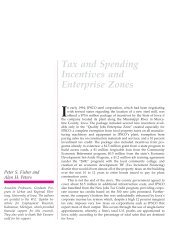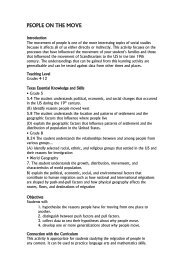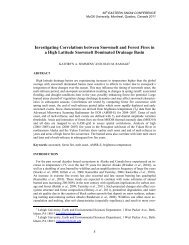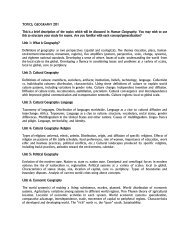Texas Social Studies Framework - Department of Geography ...
Texas Social Studies Framework - Department of Geography ...
Texas Social Studies Framework - Department of Geography ...
You also want an ePaper? Increase the reach of your titles
YUMPU automatically turns print PDFs into web optimized ePapers that Google loves.
34<br />
34<br />
Concept Related (The Way Ideas Are Organized)<br />
The organization reflects the ways in which ideas<br />
relate to each other. The fundamental ideas <strong>of</strong> the<br />
social science disciplines provide the themes for the<br />
course or the unit such as chronological themes for<br />
history and regional themes for geography. Example:<br />
A teacher develops a sixth grade unit on world<br />
population which includes the related concepts <strong>of</strong><br />
population distribution, population density, birth<br />
rate, death rate, rate <strong>of</strong> increase, doubling time, and<br />
migration. The unit examines three world regions<br />
that clearly illustrate these concepts.<br />
Inquiry Related (The Way Knowledge Is Generated)<br />
Inquiry-related organization focuses on the processes<br />
<strong>of</strong> collecting, organizing, and analyzing data;<br />
drawing conclusions; forming generalizations; and<br />
verifying knowledge. Both inductive and deductive<br />
approaches can be used. Example: A third grade<br />
teacher shares artifacts and reproductions <strong>of</strong> items<br />
used by people living in their local community 100<br />
years ago. The students examine the articles, try to<br />
determine their uses, and attempt to draw conclusions<br />
about what life must have been like at that<br />
time. They attempt to verify their conclusions by<br />
reading first-person accounts and historical fiction<br />
set in that time period.<br />
Learning Related (The Way Pupils Learn)<br />
Learning theory (behaviorist, cognitivist,<br />
constructivist) provides the basis for organization<br />
and sequence <strong>of</strong> content. Criteria such as the<br />
learner’s previous experience, the developmental<br />
level <strong>of</strong> the learner, and the level <strong>of</strong> difficulty <strong>of</strong> the<br />
content will influence curriculum developers’<br />
decisions. Example: A kindergarten teacher who<br />
takes a constructivist approach begins most units by<br />
asking students to think about a problem, share their<br />
present knowledge, identify what they would like to<br />
find out, make predictions, collect information, and<br />
think about what the information means.<br />
Utilization Related (The Way Learnings Are to Be<br />
Utilized in Life)<br />
Content is organized on the basis <strong>of</strong> procedures or<br />
anticipated frequency <strong>of</strong> use. The organization and<br />
sequence <strong>of</strong> the content reflects the steps to be<br />
followed in a procedure or the most important<br />
content is placed first in a course or unit. “Most<br />
Chapter 4: Developing <strong>Social</strong> <strong>Studies</strong> Curriculum Based on the TEKS<br />
important” means that the learner is likely to<br />
encounter this content most <strong>of</strong>ten. Example: A fourth<br />
grade teacher organizes an instructional sequence<br />
designed to result in multimedia presentations by<br />
teams <strong>of</strong> students. Skills related to outlining, preparing<br />
text slides, scanning photographs, copying<br />
images from the Web, importing images, and<br />
sequencing slides are taught in a step-by-step<br />
fashion.<br />
As educators develop grade level and course plans they<br />
should consider the implications <strong>of</strong> organization. A<br />
traditional world geography course might be organized<br />
around world regions, but there are alternative organizational<br />
schemes that might work as well or even better.<br />
Alternately, a world geography course might be thematically<br />
organized, containing units with content themes<br />
such as world population patterns, world climate patterns,<br />
food and farming, energy, etc. A thematic organization<br />
for a world geography course might lead students<br />
to a better understanding <strong>of</strong> worldwide patterns <strong>of</strong><br />
geographic phenomena, while a regional organization<br />
might help students to become more aware <strong>of</strong> similarities<br />
and interrelationships among countries that make up<br />
parts <strong>of</strong> a region. The TEKS for world geography can be<br />
met with either organizational pattern. Decisions regarding<br />
organization <strong>of</strong> a particular course/unit should<br />
depend heavily on the rationale for the course, which<br />
incorporates consideration <strong>of</strong> the goals, the learners, and<br />
the current and future demands <strong>of</strong> citizenship.<br />
HOW CAN HORIZONTAL ORGANIZATION<br />
OF THE CURRICULUM BE ACHIEVED?<br />
Horizontal organization engages the curriculum<br />
worker with the concepts <strong>of</strong> scope and integration,<br />
that is, the side-by-side arrangement <strong>of</strong> curriculum<br />
elements (Ornstein and Hunkins, 1993, p. 236).<br />
Work on the horizontal organization <strong>of</strong> curriculum<br />
provides for the correlation and integration <strong>of</strong> content<br />
from the various subjects <strong>of</strong>fered to learners at the same<br />
grade level. For example, the instruction related to the<br />
TEKS in language arts, science, social studies and<br />
technology applications could be incorporated into one<br />
thematic unit in ways that would reinforce concepts and<br />
skills common to the subjects as well as insure a broad<br />
and deep understanding <strong>of</strong> those concepts and skills.<br />
Consideration <strong>of</strong> the horizontal organization <strong>of</strong> curriculum<br />
and the provision <strong>of</strong> appropriate curriculum documents<br />
can be a powerful force in insuring the attainment<br />
<strong>of</strong> standards contained in the TEKS.
















